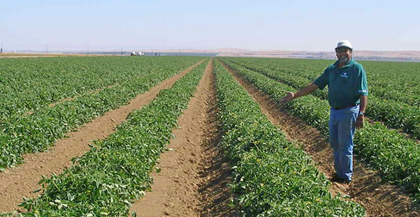California Agricultural Technology Institute
Fertilizer study shows promise for West Side vegetable crop production
Research trials aimed at increasing calcium availability in West Side San Joaquin Valley soils have shown promise for successful vegetable crop production.
The work is being conducted by a team of Fresno State plant and soil scientists, along with the help of graduate students. Leading the work is Dr. Florence Cassel Sharma, assistant professor with the Department of Plant Science.
The research is needed to provide scientific backing to anecdotal reports of methods for enhancing production of crops that do not tolerate the typically high salt content of West Side soils.
“Many San Joaquin Valley cotton growers facing low returns for cotton have sought to transition to more high value crops such as vegetables to maximize their profits,” Cassel Sharma said. However, vegetable crop production in saline-sodic soils presents unique challenges.
Vegetable crops are more sensitive to salinity than cotton and more susceptible to disease and deficiency when grown under saline/sodic conditions. For example, blossom-end rot of tomatoes is a common problem in calcium-deficient West Side soils. Irrigation water already high in salts adds to the problem.
Cassel Sharma’s research goal is to scientifically validate fertilizer and soil treatment methods that would enhance production for crops such as processing tomatoes. Collaborating in the work is Associate Plant Science Professor Dr. Dave Goorahoo and graduate student Prasad Yadavali, who conducted master’s thesis research as part of the study.
In a two-year experiment, the research team grew processing tomatoes in the Kettleman City area southwest of Fresno, California, under three treatments plus a control. The experimental treatments featured application of urea sulfuric acid, calcium ammonium nitrate, and calcium thiosulfate. The control included conventional amounts of ammonium nitrate.
The fertilizers were applied through a sub-surface drip irrigation system. During the course of the growing season soil samples were collected and analyzed for electrical conductivity, pH, calcium level and other traits. Plant leaf and fruit samples were collected and analyzed for calcium content. Incidence of blossom-end rot was measured, and total crop yield at harvest was recorded.
Results of the first growing season in 2009 were significant, with tomatoes under the calcium thiosulfate fertilizer treatments producing higher yields. However, in 2010 no significant yield differences between treated and control plots were recorded.
“Overall yields were significantly lower in 2010 than in 2009, which could be attributed to the differences in the cultivar planted by the grower or the differences in climatic conditions,” Cassel Sharma said. However, plants treated with calcium thiosulfate exhibited the lowest incidence of blossom-end rot in both years.
In another phase of results, elevated rates of sodium adsorption ratio and sodium content in the soil showed greater correlation with reduced yields and increased incidence of blossom-end rot.
“This suggests that efforts should be directed toward soil sodium amelioration using other management practices such as proper irrigation methods and gypsum application rather than application of calcium-based fertilizers only,” Goorahoo said.
Although the results over two years were not conclusive, the study is the first scientific evidence that calcium thiosulfate can reduce the incidence of blossom-end rot for tomatoes grown in salt-affected soils, Cassel Sharma reported.
“Our goal was to provide important information on the effects, whether positive or negative, of each reclamation method on tomato yield, blossom-end rot and other aspects of tomato production on saline soils,” the researcher said. “We hope these results will have applicability to different cropping systems and can benefit growers, crop managers and irrigation specialists in order to improve production in West Side soils.”
Cassel Sharma and her team have presented detailed study results through various formats and media over the past two years. For more information contact her at fcasselss@csufresno.edu
Partial funding for this project was provided by the California State University Agricultural Research Institute (ARI).
